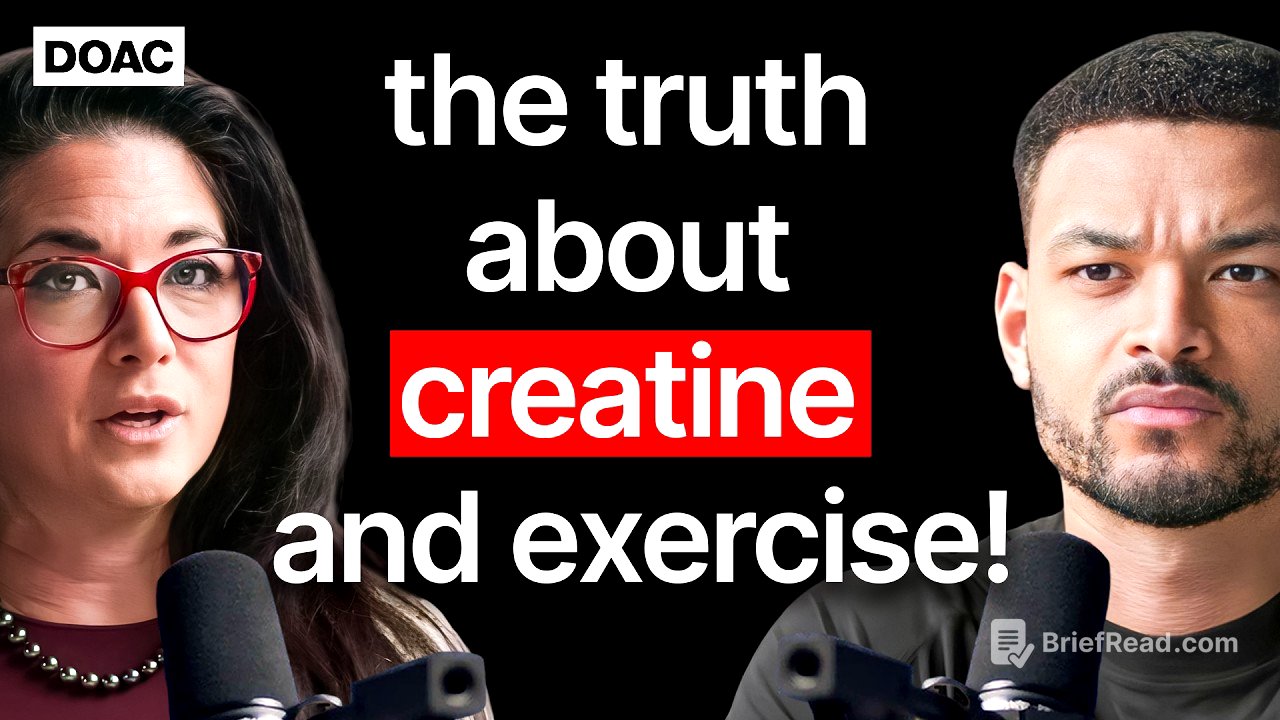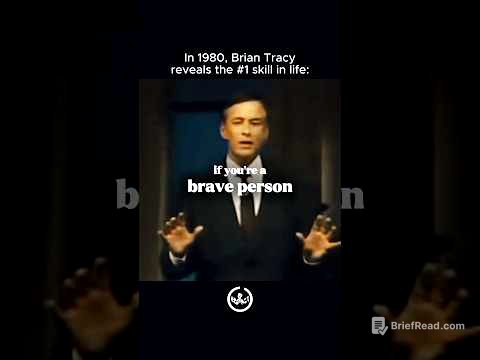TLDR;
Dr. Vonda Wright discusses longevity, bone health, muscle strength, and cognitive function, emphasizing the importance of lifestyle choices, preventative measures, and personalized approaches to health. She highlights the critical role of bones, muscles, and mindset in achieving a longer, stronger, and healthier life, particularly for women.
- Bones are master communicators, releasing proteins that affect the brain, pancreas, and muscles.
- Muscle and bone health are interconnected and crucial for longevity.
- Maintaining a healthy lifestyle, including resistance training, proper nutrition, and stress management, is essential for preventing age-related decline and diseases like osteoporosis and Alzheimer's.
Intro [0:00]
Dr. Vonda Wright is introduced as an orthopedic surgeon and longevity expert who applies her knowledge from working with elite athletes to help people live longer, stronger, and better lives. She emphasizes the importance of bone health, noting that a significant percentage of women will develop osteoporosis, which is linked to cognitive decline and increased fracture risk. She introduces her "unbreakable" lifestyle concept, which focuses on muscle, bone, nutrition, and mindset to combat bone fragility.
Vonda's Mission to Help People Live a Longer, Stronger Life [2:03]
Dr. Wright explains that her work involves applying performance science principles learned from training high-performing athletes to improve the health and well-being of everyday individuals. This includes optimizing training, nutrition, and recovery to enhance physical and cognitive performance. She highlights the importance of recovery, especially sleep, for brain function and overall health.
How Much of Vonda's Work Crosses Into the Cognitive Realm? [3:59]
Dr. Wright discusses the importance of sleep and recovery for cognitive function, prioritizing them over mobility and nutrition. She explains how the timing of workouts should align with individual brain function, and mentions a company that uses EEG to map brain pathways and retrain the brain like a muscle.
Training the Brain Like a Muscle [6:03]
Dr. Wright describes a company that uses EEG helmets to map brain activity and identify areas needing retraining. This training program aims to reallocate energy to underutilized brain pathways, improving efficiency. The concept is that the brain can be retrained like a muscle, focusing energy on specific neural pathways to improve cognitive function.
What Is Precision Longevity? [7:14]
Dr. Wright defines precision longevity as developing personalized health plans based on an individual's DNA and specific biomarkers. This approach moves away from the "one size fits nobody" model, allowing for tailored nutrition and exercise programs. She uses the example of lactate threshold testing to determine the most efficient heart rate for workouts, optimizing mitochondrial function.
How Does the Body Change in Different Seasons of Life? [9:24]
Dr. Wright emphasizes that every phase of life requires different health considerations. Bone density, muscle mass, and gut function change with age, necessitating adjustments in nutrition and exercise. For example, women in midlife may need methylated vitamins due to less efficient gut function.
Why Do Men's Bones Maintain Their Density Longer Than Women's? [11:17]
Men's bones maintain their density longer than women's due to the influence of testosterone and genetic factors, which result in thicker bones initially. The decline in estrogen levels during menopause causes women to lose bone density faster.
Is Loss of Bone Density Inevitable for Women? [12:08]
Loss of bone density is not inevitable for women. A study of master athletes showed that chronic exercise, especially impact sports, can help maintain bone density into the 80s. While estrogen loss is inevitable, osteoporosis and fractures are not, and can be prevented with the right lifestyle.
Why Bone Health Is Crucial for Overall Health [13:51]
Bones are often overlooked but are crucial for overall health. One in two women will experience an osteoporotic fracture, leading to decreased function and increased mortality. Bones are master communicators, releasing proteins like osteocalcin that have neuroprotective effects, improve insulin sensitivity, and support muscle function.
How Do Bones Release Substances Into the Body? [19:47]
Bones serve as a storehouse for essential minerals like calcium. When the body needs calcium, it signals osteoclasts to break down bone and release calcium into the bloodstream. This process maintains a fine balance, and excess calcium is excreted through the kidneys.
What's Making Your Bones Fragile? [21:52]
Several factors contribute to bone fragility, including insufficient bone development in youth due to restrictive diets and sedentary lifestyles. Breastfeeding can also lead to bone density loss if calcium is not adequately replaced. The decline in estrogen levels during perimenopause can cause rapid bone density loss.
Importance of Impact Sports for Bone Health [25:39]
Impact sports are crucial for building and maintaining bone strength. Engaging in activities like running and jumping when younger helps build bone density. Continuing to impact bones throughout life, even at 60 years old, can positively influence bone density.
How to Care for Bone Health During Pregnancy and Breastfeeding [26:42]
During breastfeeding, women lose about 500 milligrams of calcium daily and must replace it through whole foods or supplements. Mindful calcium intake is essential to rebuild bone density after pregnancy.
What Is the Bone-Brain Axis? [27:47]
The bone-brain axis refers to the communication between bone and brain via proteins like osteocalcin. Osteocalcin aids in neuroprotection by reducing oxidative stress and stimulating the growth of neurons in the hippocampus, which is involved in memory. Low bone density is associated with higher cognitive dysfunction.
What Is the Critical Decade for Bone Health? [29:20]
The critical decade for bone health is between 35 and 45 for both men and women. During this time, it's important to establish healthy habits, get baseline lab tests, and engage in mobility and resistance training. Building muscle and maintaining a high V2 Max during this period provides a buffer against age-related decline.
What Is Osteoporosis? [34:04]
Osteoporosis is defined as low bone density, measured using a DEXA scan. A T-score of -2.5 or lower indicates osteoporosis, significantly increasing fracture risk.
How Many Americans Over 50 Have Osteopenia? [35:31]
Two million men and a significant percentage (at least 50%) of women over 50 in America have osteoporosis. Early detection and intervention are crucial, but DEXA scans are often not covered by insurance until age 65, which is often too late.
Early Warning Signs of Osteoporosis [36:48]
Early warning signs of osteoporosis include a family history of shrinking height or hip fractures. Medical history, such as long-term steroid use, can also indicate increased risk.
Smoking vs. Bone Health [37:44]
Smoking is detrimental to bone health, slowing fracture healing and increasing the risk of non-union. Smokers undergoing spine surgery also have higher infection rates.
Is There a Link Between Alzheimer's and Bone Health? [38:28]
There is a correlation between Alzheimer's disease and osteoporosis, with about 30% of people with brain disease also having osteoporosis. This may be due to the connection between the two organ systems.
Alzheimer's Disease in Vonda's Family [39:09]
Dr. Wright shares her personal experience with her aunt's Alzheimer's, which motivates her to prioritize brain health. She emphasizes the importance of lifting weights and eating foods that promote brain health to prevent cognitive decline.
Would Vonda Choose an Able Body or an Able Brain? [40:57]
Given the choice between an able body and an able brain, Dr. Wright would choose an able brain, emphasizing the importance of relationships and cognitive function. She notes that these are interconnected, as movement and physical health also support brain health.
Prediabetes [41:52]
Alzheimer's disease is considered the third phase of diabetes. Prediabetes, characterized by elevated fasting glucose and hemoglobin A1c levels, significantly increases the risk of developing diabetes and Alzheimer's. Dr. Wright stresses the importance of taking prediabetes seriously and adopting a healthy lifestyle to prevent progression.
Diet for Good Cognitive Performance [46:12]
A balanced diet with lots of vegetables and high protein is essential for cognitive performance. Pro athletes don't just eat meat, they have a well-balanced diet. The amount of carbohydrates consumed can impact cognitive function, with complex carbs being better than simple sugars.
The Perfect Diet for Vonda [48:11]
Dr. Wright eats 130 grams of protein a day, prioritizing dense foods to meet this requirement. She avoids fruit except for blueberries and only consumes complex carbs.
Strong Muscles and Bones as Keys to Longevity [50:28]
Muscle and bone health are equally important for longevity. It's never too late to build strength, and the body will always respond to strategic stress. Even starting with bodyweight exercises can reverse frailty.
You're Never Too Old to Build Strength [50:48]
It's never too late to start weight training, even in your 70s. Starting with bodyweight exercises and gradually progressing to free weights and kettlebells can lead to significant improvements in strength and mobility.
Workout Strategies for Building Muscle [53:28]
Even with a 10-week break from lifting, muscle memory helps retain strength. The minimum for building muscle is a couple of days a week, progressively lifting harder. For men in midlife, it's about eight reps, four sets; for women, four reps, four sets, lifting heavy to replace the anabolic stimulus that estrogen was.
Higher or Lower Weights: What's Best for Building Muscle? [55:26]
Lighter weights with higher reps are good for hypertrophy (muscle size), while heavier weights with lower reps are better for power and strength, which are important for longevity. Dr. Wright focuses on lifting for power, using big weights for four reps and four sets.
Why Is Muscle Critical for Longevity? [56:46]
Muscle is a metabolic and endocrine organ that releases proteins like clo, ginin, and irisin, which are critical for longevity, resilience, and metabolic function. Contracting skeletal muscle stimulates the production of these proteins, benefiting various organs and systems.
Nutrients for Muscle Preservation [59:50]
To protect muscle as you age, consume one gram of high-quality protein per ideal pound. High-quality protein contains a high percentage of leucine, an essential amino acid. Creatine supplementation is also beneficial for both men and women, aiding in muscle and brain health.
How to Find Motivation to Take Responsibility for Your Health [1:03:06]
Motivation comes from feeling good every day rather than focusing on long-term promises. Making small, daily improvements and experiencing immediate benefits can sustain behavior change.
Vitamin D: Crucial for Bone Health [1:03:57]
Vitamin D, magnesium, strontium, zinc, and boron are crucial for bone health. Sleep is also very important.
How to Prevent Injury While Running [1:04:28]
Runners who only run are prone to injuries because running builds a cardiovascular engine but not necessarily muscle mass below the belly. Strengthening glutes, core, and hips is essential for stability and preventing injuries. Motion analysis can help identify imbalances and prevent predictable injuries.
Why Should People Avoid Obesity as They Age? [1:13:52]
Carrying extra weight disproportionately harms bones and joints. Cartilage, which cushions bones, is subject to damage from excessive weight. Maintaining a healthy body composition with more muscle than adipose tissue is crucial for joint health.
Strategies to Promote Motivation [1:15:44]
Tracking body composition and setting measurable goals can motivate change. Seeing data that reveals low muscle mass and high body fat can be a powerful motivator. Tools like journals and continuous glucose monitors (CGMs) can also provide valuable insights.
Myths About Menopause [1:18:32]
Common myths about menopause include the idea that women have to suffer through it. Many people are unaware of perimenopause and hormone replacement therapy (HRT). Dr. Wright encourages women to educate themselves and make informed decisions about HRT based on science, not fear.
Link Between Menopause and Bone Density [1:21:22]
Menopause is linked to bone density loss due to the decline in estrogen and testosterone. Estrogen helps control osteoclasts, the cells that break down bone. Hormone replacement therapy can help rebalance bone breakdown and rebuilding.
The Musculoskeletal Syndrome of Menopause [1:22:40]
Dr. Wright and her group created a nomenclature called the musculoskeletal syndrome of menopause to describe the collection of symptoms women experience due to estrogen loss. These symptoms include arthralgia (total body pain), frozen shoulder, sarcopenia (muscle loss), and increased tendon and ligament problems.
What Causes Arthritis? [1:27:49]
There are two types of arthritis: autoimmune (rheumatoid arthritis) and wear-and-tear (osteoarthritis). Osteoarthritis is caused by the loss of cartilage on the end of bones, leading to pain, swelling, and stiffness.
Is HRT a Remedy for Musculoskeletal Symptoms of Menopause? [1:29:09]
Hormone replacement therapy can help prevent bone loss, muscle loss, and inflammation associated with the musculoskeletal syndrome of menopause. Estrogen in HRT can prevent bone loss, prevent muscle loss, can decrease the inflammation of arthralgia and frozen shoulder.
Why Is Back Pain on the Rise? [1:30:18]
Back pain is on the rise due to sedentary lifestyles, prolonged sitting, and muscle weakness. Compression fractures of the spine can also cause low back pain, particularly in women and elderly men.
Back Pain Prevention [1:32:55]
Standing desks and walking treadmills can help prevent back pain. Holding meetings while doing wall squats can also build mobility. Studies show that moving while learning can improve retention.
Study: Age-Related Decline in Performance Among Elite Senior Athletes [1:34:21]
A study of track and field athletes showed that significant performance decline does not occur until after age 70. This suggests that slowing down before 70 is often due to lifestyle choices rather than biology.
New Book: Unbreakable [1:36:16]
Dr. Wright is working on a book called "Unbreakable," which focuses on aging and longevity, particularly for women. The book addresses the pillars of aging, explains the science behind them, and lays out a lifestyle that includes muscle, bone, nutrition, and mindset.
Link Between Menopause, Diabetes, and Alzheimer's [1:38:42]
Perimenopause and prediabetes share nearly identical metabolic changes. If prediabetes is not addressed in the critical decade, the loss of estrogen during menopause can compound insulin resistance, leading to increased diabetes and Alzheimer's risk.
The Importance of Men Knowing About Menopause [1:39:50]
Dr. Wright emphasizes the importance of men understanding the changes women experience during midlife, including bodily, attitudinal, and sexuality changes. This knowledge can foster empathy and support in relationships.
How Do You Know When To Stop? [1:41:36]
You know when it's enough when you don't love it anymore, when it becomes a grind and it's not feeding you.









